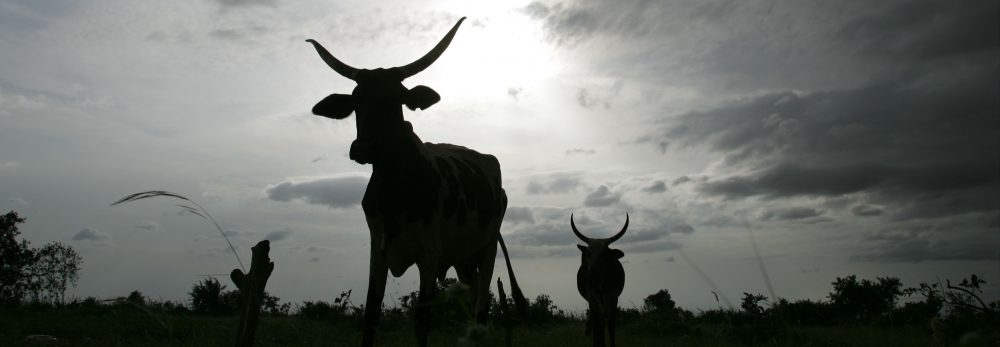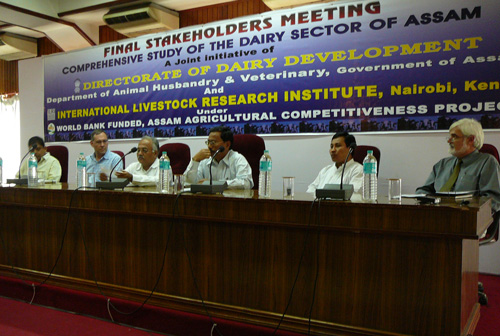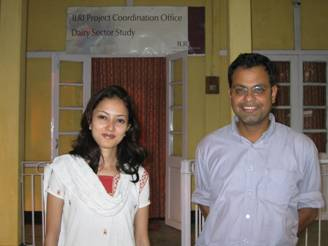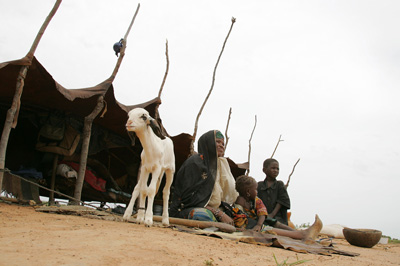|
The report, ‘Global Road Map for Improving the Tools to Control Foot-and-Mouth Disease in Endemic Settings’, launched today (17 April 2007) at the headquarters of the United Nations Food and Agriculture Organization (FAO), in Rome, envisions ‘a world in which livestock-based livelihoods, enterprises and trade can flourish unimpeded by FMD’. The road map focuses on the outputs of a workshop held in Agra, India, in December 2006.
Efficacious vaccines, strategically deployed, have revolutionized control of many infectious human and animal diseases. For FMD, which severely constrains the welfare of millions of small-scale livestock farmers in the developing world, currently available vaccines do not meet many of the basic requirements necessary for sustainable control. FMD continues to be a persistent constraint to livestock production throughout the developing world. It can significantly reduce production of milk and meat and limits the ability of draft animals to work.
|
Foot-and-Mouth Disease (FMD): Quick Facts
Foot-and-mouth disease (FMD) affects cloven-hoofed animals and is one of the most contagious diseases of mammals, with great potential for causing severe economic loss. FMD is endemic in parts of Asia, Africa, the Middle East and South America.
Hosts: Principally cattle, domestic buffaloes, yaks, sheep, goats, domestic and wild pigs and wild ruminants.
Transmission: Direct or indirect contact; animate vectors (humans, etc.); inanimate vectors (vehicles, implements); airborne, especially in temperate zones (up to 60 km overland and 300 km by sea).
Sources: Incubating and clinically affected animals; breath, saliva, faeces, and urine; milk and semen; meat and by-products and carriers, particularly cattle and water buffalo; convalescent animals and exposed vaccinates (virus can persist for up to 30 months in cattle or longer in buffalo, 9 months in sheep).
Source: Excerpted from World Organisation for Animal Health (OIE) Animal Diseases Data www.oie.int
|
According to John McDermott, deputy director general for research at the International Livestock Research Institute (ILRI), ‘FMD is a major obstacle to productivity and market access in many of ILRI’s target regions, particularly South Asia, the Horn of Africa and southern Africa. It severely limits market opportunities for poor farmers and nations wishing to access more lucrative markets, both regionally and internationally.
‘FMD also can increase the vulnerability of small-scale farmers in mixed cropping systems where animal traction is important. For example, in Southeast Asia where rice is a staple, people are heavily reliant on water buffalo for ploughing. A FMD outbreak leaves the buffalo open to secondary infections, putting these highly valued animals out of action for a very long time.’
Brian Perry, who recently retired as senior scientist at ILRI and is now collaborating with ILRI on this and other projects, says, ‘There is an urgent and long overdue need to address the special research needs of poor people in endemic FMD settings. Current research on vaccines and associated tools for the control of FMD is driven more by the needs of relatively rich FMD-free countries which are dealing with and eliminating incursions of the disease, rather than by the needs of relatively poor FMD-endemic countries which are interested in longer-term management and control of the disease.’
In early 2006, Perry, ‘navigator’ of the FMD ‘Roadmap’ process, approached the Wellcome Trust (UK) to seek support for an initiative to tackle this need. Following submission of a joint proposal from ILRI and the UK’s Institute for Animal Health (IAH), the Wellcome Trust (UK) agreed to provide partial funding and, with the support of additional donors—notably the European Union—planning was begun to organize the meeting that became the launch pad of the ‘Global Road Map for Improving the Tools to Control Foot and Mouth Disease in Endemic Settings’.
‘We decided at an early stage that the road map workshop should be held in an FMD-endemic country’, says Keith Sones, workshop facilitator and co-editor of the report. ‘India, with its impressive and ambitious ongoing program to control FMD, was an obvious choice. The Indian Council of Agricultural Research (ICAR) was very supportive and agreed to host the workshop in Agra.’
According to VK Taneja, deputy director general of animal scrence at ICAR, ‘Livestock production in India is growing faster than arable agriculture. The value of output from the livestock sector has risen over the years and is now 26% of the total value of output from agriculture. It is predicted that livestock will contribute more than half of the total agricultural output in the next 25–30 years.’
‘One of the biggest impediments to growth of the livestock sector is the large-scale prevalence of FMD’, says Taneja. ‘In most Asian countries, FMD is endemic and severely limits the region’s ability to participate in international trade. Developmental strategies for control and eradication of FMD—including improving existing conventional vaccines and diagnostics for their quality and efficacy—will pave the way for the improved growth and productivity of livestock, especially in small-farm production systems, and for ensuring their participation and access to global markets.’
While the economic losses associated with major outbreaks of FMD in industrial countries, notably in Europe in 2001, grabbed world headlines, the disease continues to cause enormous, recurrent losses across large swathes of Asia, Africa, the Middle East and South America.
‘The direct losses alone due to FMD in India are estimated to be more than USD4.5 billion per year; indirect production losses could be much more’, says Dr R Venkataramanan, principal scientist at the Indian Veterinary Research Institute, in Bangalore.
‘The Roadmap report recognizes that vaccines currently available for the control of FMD are not ideal for use in many developing countries’, says Perry. ‘To remain effective they must be kept under constant refrigeration, so the protection they offer is better suited to the needs of FMD-free countries rather than countries where the disease is a constant and daily threat. We realize that it will take considerable time to develop and make available new improved vaccines suitable for developing- country conditions. But in the meantime much can be done with current vaccines and diagnostics, especially if their use is complemented with sound epidemiological and economic decision-support tools to guide and facilitate their effective use.’
Alexander Müller, FAO Assistant Director-General, declares that ‘FAO is ready to support this important initiative, which is expected to provide some of the breakthroughs needed for use in the most affected areas, and which will support the efforts of FAO with the World Organisation for Animal Health (OIE) to reduce FMD risk by promoting progressive control of FMD at all levels. The initiative from the research community is strongly needed and we are happy to play our role in launching this initiative and facilitating transfer of effective new approaches.’
Work undertaken after the Agra workshop ensured that research proposals were developed for funding high-priority areas identified during the workshop. Lead writers facilitated development of concept notes to be submitted to donor agencies in the fields of immunology, vaccine design and epidemiological and economic tools. In addition, some regional concept notes were developed focussing on southern Africa, South and Southeast Asia and South America. These draft concept notes are included in the road map report and provide guidance on further development of the tools for FMD control. Using the products of the road map process, ILRI and partners are now developing a project proposal that, once funded, will move the world closer to the vision of ‘a world in which livestock-based livelihoods, enterprises and trade can flourish unimpeded by FMD’
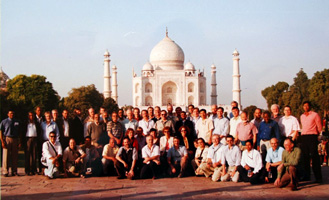
Participants of the Global Road Map for Improving the Tools to Control Foot-and-Mouth Disease in
Endemic Settings workshop held at Agra, India, 29 November – 1 December 2006
Download the FMD Road Map report
Citation: Perry BD and Sones KR (eds). 2007. Global road map for improving the tools to control foot-and-mouth disease in endemic settings. Report of a workshop held at Agra, India, 29 November–1 December 2006, and subsequent road map outputs. ILRI (International Livestock Research Institute), Nairobi, Kenya. pp. 88
|
